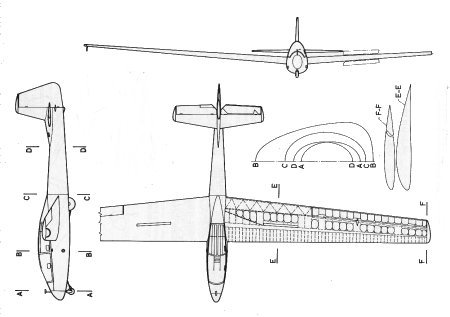HUNGARIAN
GLIDERS
1933-2000

Short history:
The Z-03B Ifjúság was developed from the Z-03A utilizing the operating experiences of the latter. The prototype first flew at May of 1956. The modifications affected the front part of fuselage. Both seats became more comfortable. The role of the glider broadened as it was suitable for blind flying instruction. This version had no better luck than the previous one. During a demonstration flight the prototype was overstressed. After a repeated stress analysis had been done and smaller modifications had been executed further 32 gliders were built between 1956 and 1959. One glider was exported to Austria.
The Z-03B Ifjúság was a middle-wing, tandem two-seater glider with mixed
light-metal-wooden structure. The wing was positioned a bit lower than that of the Z-03A. It was certified for cloud flying, basic acrobatics and spins.
The Z-03B was not an ideal basic trainer due to its high take-off mass and wing loading. Because of the lack of flaps the instructors were reluctant to let the students perform landings. The landing gear was damaged frequently. The glider was withdrawn from operation in 1960 similarly to the Z-03A type due to the unfavorable results of fatigue tests performed at Aircraft Department of the Technical University of Budapest.
.jpg)
Structure: Mixed light-metal-wooden structure, all light-metal structural elements protected by electrolyte oxidization
Wing:
On the half span of the glider's tapered wing Frise-type ailerons were fitted. The Göppingen type airbrakes were working on both surfaces of the wing. On the 80% of the span Gö-549 airfoil section were used which turned into Gö-676 sections located virtually beyond the wingtips of 2,32 m, to avoid excessive aerodynamic washout. On the outer half-span geometric washout of -3,5 degree was applied as well.
The one spar wing was built of wood. The wing was covered in front of the main spar by plywood, behind it by fabric. The half wings were connected to each-other bay a vertical main pin, and the fuselage was connected to the wings by horizontal pins. The secondary spar joint was of cardan type.
Fuselage:
The fuselage consisted of two parts. The front part - longer than that of the previous version - was light-metal monocoque structure. The glider was capable to fly with only one pilot in the front seat, as the back-seat was located at the c.g. The one part canopy opened sideways. The canopy over the back seat could be curtained off for blind-flying instruction. There was also an instrument panel fitted at the back-seat.
The second, rear part of the fuselage had elliptical cross section and was a light-metal monocoque structure with ribs and longerons. The two parts of the fuselage were connected with four pins. The landing gear consisted of a nose and a main wheel, both with rubber springs. For high winch launches hooks for Y-wire were fitted on both sides of the fuselage.
Tail unit:
The tail unit had traditionally arranged surfaces. All surfaces had light-metal structures. The stabilizers were covered bay light-metal sheets, the control surfaces by fabric.
.jpg)

| Dimensions: |
| Wing: |
| Span, m: |
15 |
| Area, m2: |
18,4 |
| Aspect ratio: |
12,2 |
| Chord (root), m: |
1,6 |
| Chord (tip), m: |
0,8 |
| Airfoil (root), m: |
Gö-549 |
| Airfoil (mid-span), m: |
Gö-549 |
| Airfoil (tip), m: |
Gö-676 (virtually beyond the wingtip of 2.32 m) |
| Dihedral, degree: |
3,5 |
| Sweep, degree: |
-1,5 |
| Washout: |
Aerodynamic and geometric of -3,5 degree |
| Aileron: |
| Span, m: |
3,87 |
| Mean chord, m: |
0,29 |
| Total area, m2: |
2,65 |
| Balancing: |
Frise |
| Flap: |
| Type: |
None |
| Airbrakes: |
| Type: |
Göppingen |
| Position (upside/downside): |
u/d |
| Total area, m2: |
0,58 |
| Position, % of chord: |
0,4 |
| Horizontal stabilizer: |
| Span, m: |
3,2 |
| Area, m2: |
2,26 |
| Elevator: |
| Span, m: |
3,2 |
| Area, m2: |
1,3 |
| Airfoil: |
Symmetrical |
| Balancing: |
Mass (inner) |
| Trim: |
Yes |
| Vertical stabilizer and rudder: |
| Total area, m2: |
1,4 |
| Rudder area, m2: |
0,96 |
| Balancing: |
None |
| Fuselage: |
| Length, m: |
8,1 |
| Width, m: |
0,73 |
| Height: |
1,12 |
| Cross section, m2: |
0,65 |
| Landing gear: |
| Type: |
Nose and main wheels, tandem arrangement |
| Wheel diameter, m: |
Nose: 0,26; main: 0,42 |
| Masses: |
| Wing, kg: |
? |
| Fuselage, kg: |
? |
| Tail unit, kg: |
? |
| Empty glider, kg: |
350 |
| Gross, kg: |
520 |
| Ballast, kg: |
None |
| Wing loading, kg/m2: |
28,3 |
| Speeds: |
| VNE, km/h: |
220 |
| Max. speed with open airbrakes, km/h: |
220 |
| Max. aerotow speed, km/h: |
130 |
| Max. winch speed, km/h: |
100 |
| Max. speed in rough air, km/h: |
130 |
| Stall speed, km/h: |
67 |
| Performance: |
| Min. sink, m/s (at gliding speed, km/h): |
1,0/71 |
| Best L/D (at gliding speed, km/h): |
22/84 |
| Start methods: |
Winch, Aerotow |

Origin of data and 3-view drawing:
Jereb Gábor: Magyar vitorlázó repülőgépek, Műszaki Könyvkiadó, 1988, Budapest
(Gábor JEREB: Hungarian Gliders, Technical Publishing House, 1988, Budapest)
Gábor FEKECS E-mail: fekecs.gabor@t-online.hu

.jpg)
.jpg)
